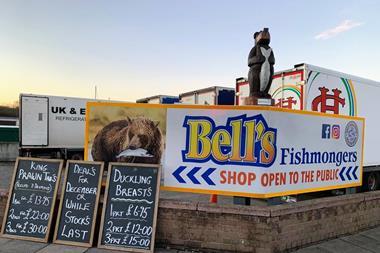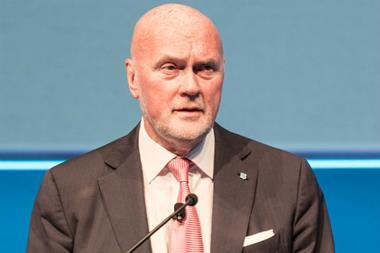...without rationalising the buying teams. Fiona McLelland reports
Job losses are usually an inevitable part of the fallout after an acquisition, but not for the trading teams from Budgens and Londis.
When the Musgrave Budgens-Londis group was formed last July, all 32 buyers from Budgens and Londis moved to the new headquarters in Harefield, Middlesex.
Budgens’ ambient trading controller Barry Williams and senior trading controller for fresh Steve Carter locked themselves away with Londis’s trading directors John Taylor and Kenton Lawton to formulate an integration plan.
“The four of us thrashed it out as there were many big discussions to be had,” says Williams, who now heads the MBL buying team. “When you put two businesses the size of Budgens and Londis together, the first things you have to look for are the benefits of synergy.
“We had to ask whether we really needed two sets of petfood buyers, for example. The answer was no, but we decided we wanted to bring everyone with us and develop a bigger team that was more category and product-focused.”
The structure of the team has been based around the Musgrave model used in Ireland. Each of the buyers’ portfolios has been reduced by a third so that they have more time not only to focus on the needs of the retailer but also to build stronger relationships with suppliers.
“It will be more challenging but much more rewarding,” says Williams. “Prior to the merger, relations with suppliers tended to be all about the deal and we used to spend all our time beating up suppliers about better terms given to the multiples.
“But now that we have reduced everyone’s portfolio, they can put more focus on building more stable relationships, rather than boom or bust. In that way we can tap into extra resources and use the suppliers’ knowledge for our mutual benefit.”
Williams admits that it will take time for suppliers to believe that there is a new culture at MBL and that it will take more than just talk.
“Our suppliers are very cynical. We will only be able to get them to appreciate what we are trying to do if we can open up a bit more and enter into more meaningful contracts.”
Relationships with retailers are also getting extra attention. Williams says that he is trying to combine Londis’s strength in service to independents with the processes and discipline from the corporate background of the Budgens team.
“We needed to get to the middle ground. We didn’t want to dictate to the independents, but at the same time we had to avoid being soft in implementation of plans.”
Williams oversees three business units, which are led by Carter, Taylor and Lawton. Carter leads the fresh buying team and one of his first challenges is to strengthen the range and improve distribution.
“We don’t have a robust chilled supply chain in Londis at present and a lot of investment is needed. Londis retailers have told us that chilled is an opportunity for them and it’s Steve’s responsibility to take all the expertise in Budgens, which is excellent in fresh, and build that into Londis.” The situation is reversed in impulse categories, where Taylor is focusing on bringing Londis’s expertise to Budgens, while Lawton is aiming to drive excitement and point of difference into staple grocery, such as building an excellent international range, says Williams.
Although the buying department is now fully integrated, Williams says it is battling against a “funnel effect”. A buyer will strike one deal with a supplier for Budgens and Londis, but the information has to go through separate IT systems and supply chains.
Williams says that by the end of 2005 MBL will be fully integrated and ready to build on current growth. “We are already seeing gradual improvement but when we get to the end of the year we will be able to switch off one of the systems and then we’ll really see all the changes beginning to take effect.
“The overriding issue is to build MBL into a group that can serve its 2,500 independents and double in size over the next three to five years.”
Job losses are usually an inevitable part of the fallout after an acquisition, but not for the trading teams from Budgens and Londis.
When the Musgrave Budgens-Londis group was formed last July, all 32 buyers from Budgens and Londis moved to the new headquarters in Harefield, Middlesex.
Budgens’ ambient trading controller Barry Williams and senior trading controller for fresh Steve Carter locked themselves away with Londis’s trading directors John Taylor and Kenton Lawton to formulate an integration plan.
“The four of us thrashed it out as there were many big discussions to be had,” says Williams, who now heads the MBL buying team. “When you put two businesses the size of Budgens and Londis together, the first things you have to look for are the benefits of synergy.
“We had to ask whether we really needed two sets of petfood buyers, for example. The answer was no, but we decided we wanted to bring everyone with us and develop a bigger team that was more category and product-focused.”
The structure of the team has been based around the Musgrave model used in Ireland. Each of the buyers’ portfolios has been reduced by a third so that they have more time not only to focus on the needs of the retailer but also to build stronger relationships with suppliers.
“It will be more challenging but much more rewarding,” says Williams. “Prior to the merger, relations with suppliers tended to be all about the deal and we used to spend all our time beating up suppliers about better terms given to the multiples.
“But now that we have reduced everyone’s portfolio, they can put more focus on building more stable relationships, rather than boom or bust. In that way we can tap into extra resources and use the suppliers’ knowledge for our mutual benefit.”
Williams admits that it will take time for suppliers to believe that there is a new culture at MBL and that it will take more than just talk.
“Our suppliers are very cynical. We will only be able to get them to appreciate what we are trying to do if we can open up a bit more and enter into more meaningful contracts.”
Relationships with retailers are also getting extra attention. Williams says that he is trying to combine Londis’s strength in service to independents with the processes and discipline from the corporate background of the Budgens team.
“We needed to get to the middle ground. We didn’t want to dictate to the independents, but at the same time we had to avoid being soft in implementation of plans.”
Williams oversees three business units, which are led by Carter, Taylor and Lawton. Carter leads the fresh buying team and one of his first challenges is to strengthen the range and improve distribution.
“We don’t have a robust chilled supply chain in Londis at present and a lot of investment is needed. Londis retailers have told us that chilled is an opportunity for them and it’s Steve’s responsibility to take all the expertise in Budgens, which is excellent in fresh, and build that into Londis.” The situation is reversed in impulse categories, where Taylor is focusing on bringing Londis’s expertise to Budgens, while Lawton is aiming to drive excitement and point of difference into staple grocery, such as building an excellent international range, says Williams.
Although the buying department is now fully integrated, Williams says it is battling against a “funnel effect”. A buyer will strike one deal with a supplier for Budgens and Londis, but the information has to go through separate IT systems and supply chains.
Williams says that by the end of 2005 MBL will be fully integrated and ready to build on current growth. “We are already seeing gradual improvement but when we get to the end of the year we will be able to switch off one of the systems and then we’ll really see all the changes beginning to take effect.
“The overriding issue is to build MBL into a group that can serve its 2,500 independents and double in size over the next three to five years.”

















No comments yet